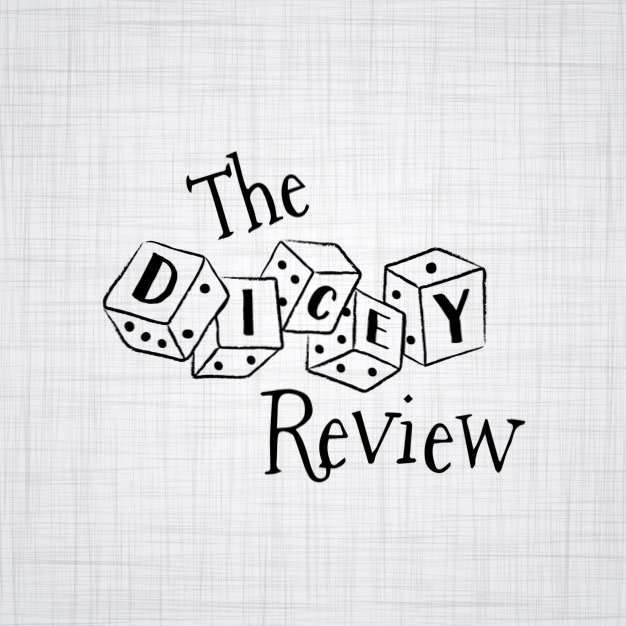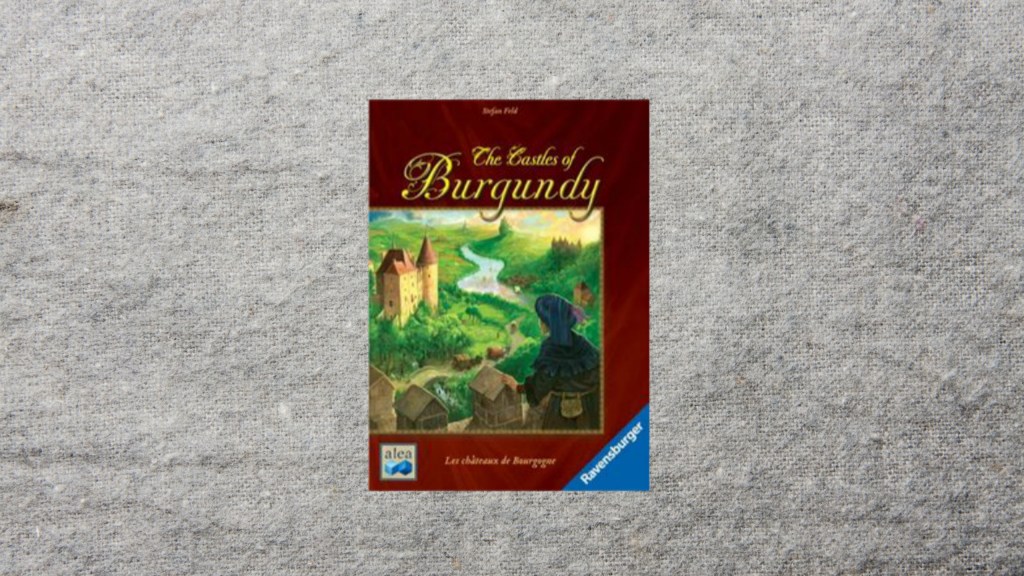Hello Dear Reader,
I know it’s been a little while since I’ve written an article and I apologize! I’ve moved houses and this has created a number of problems for my gaming. Namely, I had the large majority of my collection in storage. I did manage to select a few games to keep in the apartment to make myself learn them. The one upside to the whole moving and having no internet situation is that I had no gaming console or TV to distract me from some serious rulebook dissection. For some reason the rulebook to the featured game today: The Castles of Burgundy has always been hard to get through. I don’t think I really ever gave it the old college try so to speak but thanks to my wifi-less environment I finally took the time to buckle down and learn this titan of the Euro Game world. Man…am I glad I did.

When you first look at The Castles of Burgundy on the store shelves you may look right over it because flashy it is not. The Castles of Burgundy was released by Ravensburger and to me feels like it comes from the old guard of Euro greatness even though it was released in 2011. It stands with games like Puerto Rico and Agricola as top tier, world class Euro games when people give suggestions for what to play. After playing The Castles of Burgundy a decent number of times I can wholeheartedly agree with all the good press the game has received. Firstly the designer is one you may know: Stefan Feld. If you don’t know Stefan Feld that’s ok but I’m hoping that this article along with the how to play video I plan to produce will bring him to your attention.
As I’ve stated in many of my other reviews I’m fairly new to tabletop gaming and have only seriously been playing since early 2015. Since I am newer to the hobby I have the joy of going through the back catalog of games from prestigious designers. The first designer I started with was Uwe Rosenberg, and that has been a fun journey. I’m now exploring the catalog of Stefan Feld and this is just as much fun but completely different in every way. There are a few significant differences in the way that these two designers work. Where as Uwe is about optimization within a very tight framework, Stefan is about optimization in a system filled with abundance. There are so many points, so many choices and a bit of randomness thrown in for good measure. This isn’t to say that Stefan Feld’s games aren’t superbly designed or unbalanced, it’s simply to say that you get a much different feel playing a Stefan Feld game than most other tight Euros. In Castles of Burgundy, as with many other Feld titles that I have played, the points flow freely and most of your choices feel like good choices. Even if your choices aren’t necessarily as good as they could be they feel good.

There is one thing about The Castles of Burgundy that hit me from the very beginning of my exposure to it. The basic framework of the game system is fairly straightforward. The mechanics are satisfying and make sense. Within that solid mechanical system, there are tons of choices that will impact you in different ways and make each play feel unique. So even though the game is very simple in its initial offering take one of four actions based on what you roll, actually picking those actions to maximize your effectiveness is very interesting indeed. I’ll go into a bit more depth about the types of actions you can take and the types of choices those actions present.

The board is set up in a circular fashion where tile depots around the board will determine which dice are required to take tiles from that depot. So, for instance, there is a number one depot that has access to two – four tiles depending on the number of players. The depots go from one to six to match what you can roll on your dice. At the start of the round, each player rolls their dice and plans their actions. Then each player in turn order gets to take two actions with their two dice. The first type of action you can take is placing a tile from one of the depots in your tile storage. This action is simple, you can spend a die showing a three, to take any of the tiles from the depot next to the three. Your tile storage space can store up to three tiles so that limits you a bit, but in general, that’s the first action you can take.

The second action you can take is building tiles from your tile storage onto your player board that shows your own personal kingdom. This is where a lot of the game’s choice and complexity comes in. There are a number of different tiles that will give you special bonuses when you build them, at the end of the round or at the end of the game. You could build one of the eight different buildings to start building up city zones on your player board. Each of the eight buildings gives you a special bonus whether it be taking a tile from the middle with no required action or gaining silver etc. You could build a castle that will then allow you to take a free action as if you had a die of any result. You can place livestock tiles that will give you bonuses if you combo animals of the same type. You can place ships that let you gather goods to sell and move you on the turn order track. These are just a few examples of all of the available options to players. All of this goes to show that the options in this game are many and the rewards are good.

In addition to all of the bonuses that these tiles give you rewards are given for completing all of a certain type of tile first. So for instance, if you are the first player to complete a zone or all of the castles on the board you will gain bonus victory points. So there is a high reward for efficiency both with your time and your tile placement, which is quite satisfying when you get a really interesting combo to work. Usually, I will try to go for the bonuses or actions that other players are not pursuing, which usually means that I’m doing something completely different than the game before. This variability is a huge strength to The Castles of Burgundy. I haven’t even begun to scratch the surface of the other parts of the game that can be mixed like the unique player boards or expansions that can be purchased, just the base box provides quite a bit of content.

The Castles of Burgundy stands a cut above most games. There are certain games that when you play them you instantly feel the genius behind the design even if the game is not your speed. When you feel the genius and you also love the mechanics then you truly have a wonderful experience ahead of you with many plays to come. With the expansions mentioned above that are available to provide more variability and more player boards to provide a different target, I think I’ll be interested for years to come.

I’ve currently collected five of Stefan Feld’s games and The Castles of Burgundy is my favorite. There’s plenty of tension at two players but three and four play very well too. Strategies will change based on the player count but the balance will not and I feel that this is another reason that the genius of this design is evident. For instance, in a four player game good tiles are much more important at four points each, but in a two player game, you can win without focusing solely on them. In a four player game, the goods are worth more but they are harder to get, so it tends to even out.
Another incredible aspect to The Castles of Burgundy is the price tag. At $42 USD I feel that the content you receive for the investment is outstanding. The tile laying and puzzle solving aspects will keep your mind engaged and the free flowing points will keep you satisfied as you explore this strategic sandbox of a game. I would highly recommend picking The Castles of Burgundy up if you get the chance and if you don’t like it let me know and I may buy it off you!
I’ve placed a how to play video below if you want to see how the game plays. We hope you enjoyed the content and the review. If you have any questions please email thediceyreview@gmail.com. Thanks so much and until next time we’ll see you at the table!
Paul


